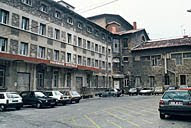The house Judgement of Limoges: what future for prison?

The prison Limoges
(source: www.annuaires.justice.gouv.fr )
A new prison with 700 spaces will be constructed of by 2014 in the Limousin. This project will likely sign the death of the current prison Limoges. The announcement is both baffling (the prison was enlarged in 2007) and want to to its bulk. It is now echoing the closing of the house arrest of Gueret (23) in 2015. The place of location of the new prison has yet to find, even if the city Couzeix (on the outskirts of Limoges) is discussed. Moving house arrest in new buildings is positive news for those campaigning for improved conditions of detention. Remand hosting defendants awaiting trial or inmates of short duration (just under a year) have indeed serious problems of overcrowding. The inspection report of the remand of Limoges in December 2008 by the Comptroller General of places of detention highlights the problems of overcrowding and dilapidation of the building. According to the report, " the occupancy rate of the male ward is 216%, the women's quarters of 170% and the area of semi-freedom, 150%. Apart from the minors, empty and renovated, individual cells is virtually impossible in the male ward. [...] housing conditions are unworthy . "(www.cglpl.fr)
Even if the future of the prison is still unknown, opening a new prison (which includes a house of arrest and detention and / or a home center) gives the prison Limoges few alternatives to closure. The example of the house arrest of Limoges is not a marginal case. In a movement to modernize French prisons, Mr. Minister Alliot-Marie announced the closure of many prisons. Very few
valued, we see today disappearance of the prison area of the 19th century. Built in 1853, the house arrest of Limoges was commissioned in 1856. The prison then comprises three wings that converge into a surveillance room. A chapel was also built. Men, women and children (up to 150 inmates) are in prison, in cells or dormitories. Today, " the main building is constructed as a cross with a central portion which is the men's quarter (QH) and two lateral parts which comprise, on the left side, the women's quarters (QF) and UCSA and on the right side, neighborhood of semi-freedom (QSL) and the minors (QM). Besides the 3 disciplinary cells, the jail has 82 cells: -56 for men, -11 to minors, -10 for women, -5 for semi-free (four QSL for men and one QF) . (Www.cglpl.fr)
Besides the built heritage of Limoges, such as St. Stephen's Cathedral or Abbey of the Rule, the prison has its place in the social history of the city. In early 1905, strikes broke out in the revolutionary shoe factories and porcelain of the city. Demonstrators protest against conditions Work hard. On 17 April a group of 3,000 people went to the prison to issue workers, then jailed for theft.

Bloody riots in Limoges, protesters trying to break through the prison gates illustration that appeared in Le Petit Journal, April 30, 1905 (source: www.philippepoisson-hotmail.com.over -blog.com)
The photographs of Henri Manuel gives us other valuable evidence of the house arrest of Limoges in the early twentieth century. Official Photographer of the French government from 1914 to 1944, began producing Henri Manuel a large portrait of remand (Lille, Fresno, Limoges ...) and house plants (Haguenau, Montpellier, Melun ...). Made between 1929 and 1931 on the initiative of the Department of Justice, the photographs are " published in newspapers or broadcast form of postcards . (Www.rhei.revues.org/index56.html)

Held upright on his bed by the window .
Remand Limoges, 1930. Photo
Henri Manuel (source: www.justice.gouv.fr)

Supervisors stationed at the Registry office .
Remand Limoges, circa 1930 Photo
H. Manual. Collection of the National Museum of Prisons.
(source: www.criminocorpus.revues.org)

A prisoner sitting on his bed reading .
Remand of Limoges, 1930. Photo
Henri Manuel (source: www.justice.gouv.fr)
The photographer does not show here the prison as a place exclusively detention and punishment, but stressed the possibility of redemption. (Www.rhei.revues.org/index56.html) The photographer discusses the acquisition by reading or prayer. The cells are both bathed in bright light and bright. The source of light from the window of the cell to which the two prisoners are shot. Light, everywhere here, appears as the possibility of redemption, the redemption of the inmate. Henri Manuel performs a wide and comprehensive portrait of prison life: the cell (the importance of this law since cell 1875), the activities of inmates and staff. He photographed such as prison guards of Limoges, who since August 2, 1919, are called supervisors.
This prison, historic building, is fully part of the heritage of Limoges. If closing the prison is formalized, to find a new job, change career, would be a great challenge for the city. Obsolete for the most part, the prison has little chance of being retained against the many opportunities offered at the location of the prison (place Winston Churchill), near the center of Limoges. While many conservation Limoges defend the prison-compliance of the place and its identity-the prison heritage is generally little considered and valued. Today the field of 19th century prison is disappearing. Although it is too early to decide about the future of this prison, the chances that the building be preserved and restored are low.
Source: www.city-
limoges.fr
www.cglpl.fr
www.cg87.fr
www.rhei.revues.org
www.justice.gouv.fr

























